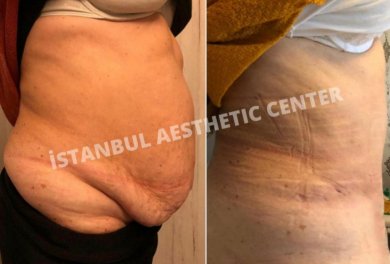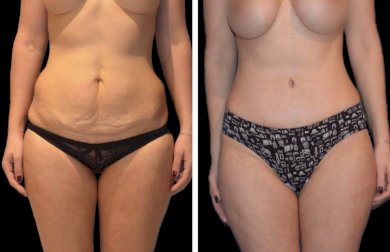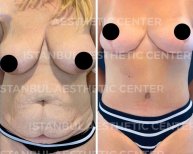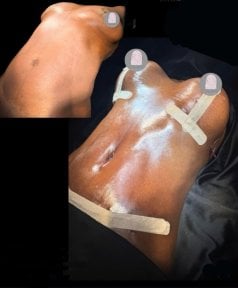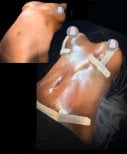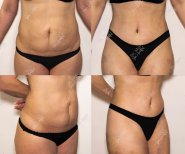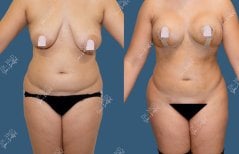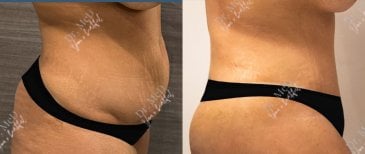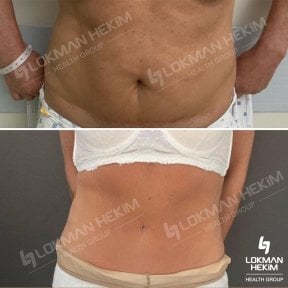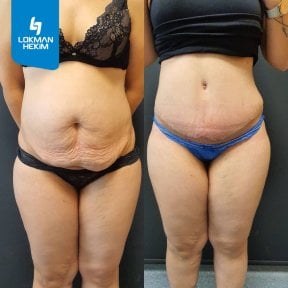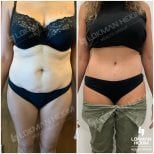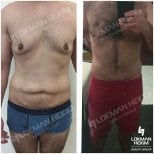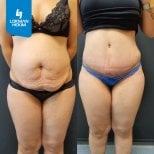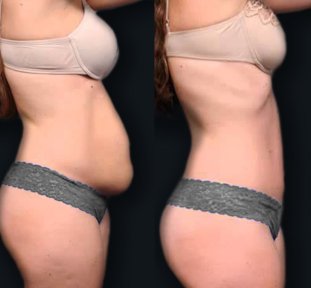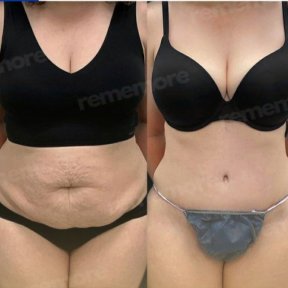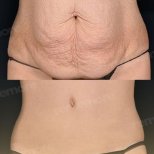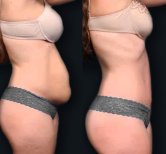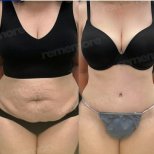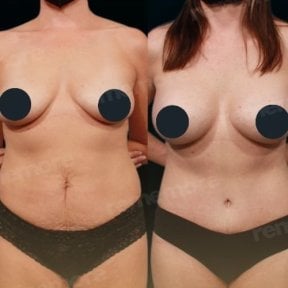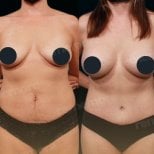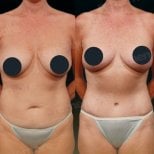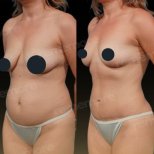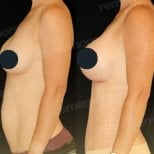This award-winning package from Dr. Ergin Er, a 1st-prize winner of the Turkish Society of Plastic Surgeons, costs around $5,520. That covers the surgery, 2 hospital and 6 hotel nights, pre-op blood work, medications, a compression garment, and VIP airport transfers. Istanbul Aesthetic Plastic Surgery Center has a 4.8/5 rating from 224 patients with a 97% recommendation rate, reflecting its focus on over 4,000 annual aesthetic procedures.
What Is a Tummy Tuck?
A tummy tuck, or abdominoplasty, involves removing belly fat surgically and tightening the muscles. It helps people who have loose skin after pregnancy or weight loss or those with a stubborn belly bulge that won't go away with diet and exercise.
The goal of the surgery is a flatter, firmer stomach and a more defined waistline. As a result, clothes fit better, movement feels easier, and self-confidence returns.
Abdominoplasty: Options and Techniques
Classical methods
1. Full abdominoplasty. Ideal for loose skin, muscle separation, and stubborn belly fat. This comprehensive procedure removes excess skin, tightens the muscles, and repositions the belly button. The surgeon makes a horizontal incision 2–3 cm above the pubic hairline, repairs separated abdominal muscles using permanent sutures, and repositions the navel to maintain a natural appearance.
2. Mini abdominoplasty. A good option for minor skin sagging below the navel. A mini procedure requires a smaller incision and does not involve muscle tightening in the upper abdomen.
3. Extended (360 abdominoplasty). A 360 procedure combines abdominoplasty with liposuction around the waist, back, and flanks to reshape the entire midsection. Best for patients who need a dramatic transformation.
4. Fleur de lis procedure. Designed for patients who have lost a lot of weight (e.g., after bariatric surgery). It involves two incisions: one horizontal (like a typical procedure) and one vertical down the midline of the abdomen.
Innovative techniques
Patients with more specific concerns can consider these targeted approaches:
1. Plus-size. This option is also known as a high-BMI abdominoplasty. It is designed specifically for people whose BMI is over 30 kg/m². A plus-size procedure includes extensive liposuction and muscle tightening while maintaining safe surgical limits.
2. Skin-only. Some patients don't have fat to lose or muscles to tighten, just loose skin that won't shrink back. This option removes excess skin without touching the muscles.
3. Drain-free. A less invasive option for those worried about a difficult recovery. Advanced stitching techniques help avoid post-op drains by leaving little space for fluid build-up. As a result, patients don't have to worry about emptying their drains and have a less visible scar.
Find out more about abdominoplasty types.
Abdominoplasty vs. Liposuction: What's the Difference?
Abdominoplasty surgery and liposuction both reshape the abdomen, but they address different issues.
- An abdominoplasty removes excess skin and tightens abdominal muscles. It's the best choice for those with loose skin after weight loss or pregnancy.
- Liposuction only removes fat and is best for patients with good skin elasticity who don't need skin tightening or muscle repair.
Who Is a Good Candidate for Abdominoplasty?
This surgery is an excellent option for those who:
- Have loose, sagging skin after weight loss or pregnancy
- Struggle with a bulging belly due to separated muscles (diastasis recti)
- Can't get rid of stubborn lower belly fat, even with diet and exercise
- Have excess skin after bariatric surgery
- Want a flatter, firmer stomach and a more sculpted waistline
- Have a BMI lower than 30 kg/m² (those with a higher BMI can opt for a plus-size option)
- Are women who don't plan to have children in the future (since pregnancy can stretch the skin and muscles and reverse the results)
- Are in good health and have a stable weight
- Are non-smokers, or are willing to quit
Why Have an Abdominoplasty in Turkey?
- Aesthetic plastic surgery powerhouse. Turkey ranks 6th globally in the number of plastic surgeries performed, with 425 clinics offering tummy tuck procedures through verified networks.
- Affordable prices. A Turkish belly procedure costs 50–70% less than in the UK or US, with all-inclusive packages starting from $4,100.
- World-class surgeons. Leading specialists such as Dr. Ergin Er at Istanbul Aesthetic Plastic Surgery Center, Dr. Murat Yaman at Lokman Hekim Istanbul Hospital, and Dr. Muhammet Mustafa Aydinol at Dr. MED are trained internationally in the US, Europe, and Japan. They are certified by organizations like the European Board of Plastic Reconstructive and Aesthetic Surgery (EBOPRAS), the American Academy of Cosmetic Surgery (AACS), and the American Society of Liposuction Surgery (ASLS).
- Accredited clinics. Looking for the best place for abdominoplasty? Leading facilities such as Istanbul Aesthetic Plastic Surgery Center (4.7/5), Dr. MED (4.9/5), and Lokman Hekim Istanbul Hospital (4.8/5) in Istanbul, Antalya, and Izmir meet JCI and ISO standards, ensuring European-level medical care.
- Comprehensive packages. Packages include airport transfers, 4–5-star hotels, pre-op tests, medications, and follow-up care.
Turkey's reputation for excellence is reflected in patient experiences. One patient who underwent treatment at Istanbul Aesthetic Plastic Surgery Center shared: "Istanbul Aesthetic Center was amazing and the staff couldn't have been more helpful. Dr Ergin Er explained everything before my surgery and checked on me every day whilst at the hospital. Even when I left Istanbul and arrived home if I had a concern, I knew I could message Yasin and he always replies within minutes."
How Does a Stomach Tuck Work?
Abdominoplasty is a well-structured procedure that takes 2 to 5 hours. Here's what to expect:
Preparation
You'll have a consultation with your surgeon to discuss your goals and medical history. You will need:
- Blood tests and a health check
- To stop smoking and avoid blood-thinning medications
- To maintain a stable weight before surgery
The surgical procedure
1. Anesthesia. You'll be under general anesthesia, so you won't feel any pain or discomfort during the surgical procedure.
2. Incisions. Plastic surgeons make a low horizontal incision across the lower abdomen (just above the pubic area).
3. Muscle repair. The medical team tightens the abdominal muscles using permanent sutures to repair muscle separation (diastasis recti) and create a firmer core.
4. Skin & fat removal. Excess fat and skin are trimmed away, and the remaining skin is pulled down and smoothed.
5. Belly button repositioning. In a full procedure, the navel is repositioned to fit your new shape while maintaining a natural appearance.
6. Closing the incision. The skin is sutured carefully, sometimes with drain-free techniques to reduce fluid buildup and minimize scarring.
|
Surgery time |
Hospital stay |
Recovery time |
|---|---|---|
|
2–5 hours |
1–2 nights |
4–6 weeks for full recovery |
Can you combine abdominoplasty with other plastic surgery procedures?
Yes! This procedure is often combined with:
- liposuction;
- breast surgery (augmentation, lift, or reduction);
- BBL (Brazilian Butt Lift);
- mommy makeover.
Combining procedures can save time and reduce recovery periods, as you only go through anesthesia and healing once. However, the decision depends on your health, the surgeon's recommendations, and how much surgery your body can handle at once.
Healing and Recovery After Abdominoplasty
While everyone heals at their own pace, most cases fall under a standard recovery timeline.
|
Timeframe |
What to expect |
|---|---|
|
Days 1–2 |
You'll stay in the hospital for monitoring, pain management, and help with walking. Swelling and discomfort peak during the first days but gradually decrease. Moving and walking prevents blood clots. |
|
Days 3–6 |
Rest is essential, and movement should be minimal. |
|
Weeks 1–2 |
It's recommended that you wait at least 7 days before flying home after the procedure. Long flights require precautions like walking and wearing compression garments. If you have drains, they're usually removed around this time. About 70% of patients can return to desk work by week 2. |
|
Weeks 3–4 |
Most daily activities can resume, but no intense workouts. The swelling starts to go down, and the incision begins to fade. |
|
Weeks 6–8 |
You can return to light exercise, and about 60% of swelling disappears. The clothes fit better, but the final results are still developing. |
|
Months 3–6 |
The final results settle in. The abdomen looks more defined, and scars start to fade. |
A patient who had abdominoplasty at Lokman Hekim Istanbul Hospital reported: "The operation itself, the anaesthesia and the result of the operation went without any problems. I am very satisfied with everything, I recommend it."
Post-surgery care
- Compression garment. Wear it 24/7 for at least 4–6 weeks to minimize swelling and support healing.
- Movement restrictions. Avoid bending, lifting, or intense activity for at least 1 month.
- Sleeping position. Sleep on your back with your legs slightly elevated to avoid pulling on the incision.
- Hydration & diet. Eat protein-rich foods and drink plenty of water to speed up healing.
Risks and Possible Complications
According to a comprehensive clinical study of 25,478 abdominoplasty procedures, over 96% of patients experience no major complications. However, like any surgery, it comes with certain risks:
- Minor complications affect approximately 29% of patients and may include temporary swelling, bruising, or numbness that resolve during recovery.
- Infection. Infections can occur if wounds aren't cared for properly. Accredited clinics follow strict hygiene protocols and prescribe antibiotics, keeping infection rates under 1%.
- Seroma (fluid buildup). This occurs in about 25% of cases, particularly in post-bariatric surgery patients. Surgeons place drains or use special suturing techniques to reduce the risk. If it happens, fluid can be drained easily.
- Hematoma. Bruising is normal, but excessive bleeding under the skin may require drainage in rare cases.
- Blood clots. Moving around early and wearing compression stockings significantly reduces this risk.
Reputable clinics provide follow-up care and virtual consultations, so you won't be left to your own devices if you experience concerns or complications.
The best way to minimize risks is to choose a qualified, experienced surgeon. Bookimed can connect you with 425 verified clinics in Turkey, including top-rated facilities like Dr. MED (4.9/5), Lokman Hekim Istanbul Hospital (4.8/5), and Istanbul Aesthetic Plastic Surgery Center (4.7/5).
Results: What to Expect and When
The first changes are visible immediately, but swelling can mask the final outcome. Most patients see a major improvement by 6–8 weeks. It takes 3–6 months for the abdomen to settle completely.
Patient satisfaction rates are consistently high across studies. Research by the American Society of Plastic Surgeons found that 94% of patients were satisfied with abdominoplasty results, with 97% stating they would choose the procedure again. Beyond aesthetic improvements, patients experience significant functional benefits: 68% report improved hygiene, 72% experience better mobility, and 80% see enhanced general functional capacity.
- Scars. The surgery leaves a low-placed scar that fades over time but never fully disappears. Scar creams, laser treatments, or tattoos can help make it less visible.
- Stretch marks. If you have stretch marks on the treated area, they will be removed, but those outside will remain.
- Longevity. Results of fat removal last a lifetime if weight stays stable. Pregnancy or major weight fluctuations can affect the outcome.
How to Prepare
Although Turkish clinics make the process as smooth as possible, getting abdominoplasty abroad requires some planning. Here's what to keep in mind before your trip:
- Visa. Travelers from the UK, EU, and US can stay visa-free for up to 90 days. Others can apply for an e-Visa online in minutes.
- Length of stay. Plan for 7–10 days—typically 1–2 nights in the hospital and 5–7 days in a hotel for check-ups and recovery before flying home.
- Currency & payment. Clinics accept Turkish Lira (TRY), USD, EUR, and GBP. Payments can be made by credit card, bank transfer, or cash—but check with your clinic beforehand.
- Traveling alone vs. bringing a companion. You can travel alone, as clinics provide all the necessary assistance. However, many patients find it psychologically easier to bring a relative or friend for support. For such cases, clinics often include accommodation for one companion in their packages. However, always check with your clinic directly, as conditions differ between providers.
How Much Is Abdominoplasty in Turkey?
Prices range between $4,100 and $7,000, which is 50%–70% cheaper than in the US ($11,000–$15,000) or the UK (£8,000–£10,000).
According to Bookimed's Finance Policy, the costs listed on the website are direct clinic prices, meaning you pay the clinic's official rate with no hidden fees.
What's included in the cost: Turkey vs. US and UK
|
Service |
Turkey |
US/UK |
|---|---|---|
|
Surgeon's fee |
✅ Included |
✅ Included |
|
Anesthesia & pre-op tests |
✅ Included |
❌ Extra charge |
|
Hospital stay |
✅ 1–2 nights |
❌ Usually outpatient |
|
Post-op medications |
✅ Included |
❌ Extra charge |
|
Compression garment |
✅ Included |
❌ Extra charge |
|
Hotel stay |
✅ 4–5 nights |
❌ Not included |
|
Airport & clinic transfers |
✅ Included |
❌ Not included |

